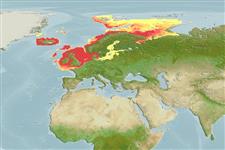Common names from other countries
Environment: milieu / climate zone / depth range / distribution range
Ecologia
marinhas demersal; intervalo de profundidade 1 - 300 m (Ref. 35388). Temperate; 81°N - 48°N, 25°W - 62°E
Northeast Atlantic: southern Norway north to Barents Sea including Novaya Zemlya, Spitsbergen and Bear Island, also Iceland.
Tamanho / Peso / Idade
Maturity: Lm ? range ? - ? cm
Max length : 15.0 cm TL macho/indeterminado; (Ref. 4645)
Descrição suscinta
Morfologia | Morfometria
Suction disc much larger than the eye diameter. Dorsal and anal fins overlap with the caudal fin. Two nostrils on each side of the snout (Ref. 35388).
Occurs from the subtidal zone to less than 300 m (Ref. 4702). Feeds primarily on crustaceans, occasionally fishes and polychaetes (Ref. 4702). Spawns in the winter (Ref. 35388).
Ciclo de vida ou comportamento de acasalamento
Maturidade | Reprodução | Desova | Ovos | Fecundidade | Larvas
Perlmutter, A., 1961. Guide to marine fishes. Bramhall House, New York. 431 p. (Ref. 169)
Status na Lista Vermelha da UICN (Ref. 130435)
CITES (Ref. 128078)
Not Evaluated
Ameaça para os humanos
Harmless
Uso pelos humanos
Ferramentas
Relatórios especiais
Baixar XML
Fontes da internet
Estimates based on models
Preferred temperature (Ref.
115969): 4.9 - 11.4, mean 8 (based on 512 cells).
Índice de diversidade filogenética (Ref.
82804): PD
50 = 0.5000 [Uniqueness, from 0.5 = low to 2.0 = high].
Bayesian length-weight: a=0.00525 (0.00237 - 0.01161), b=3.15 (2.96 - 3.34), in cm Total Length, based on LWR estimates for this (Sub)family-body shape (Ref.
93245).
Nível Trófico (Ref.
69278): 3.6 ±0.58 se; based on food items.
Resiliência (Ref.
120179): Baixo, tempo mínimo de duplicação da população 4,5 - 14 anos (Fecundity assumed < 100).
Fishing Vulnerability (Ref.
59153): Low vulnerability (10 of 100).
